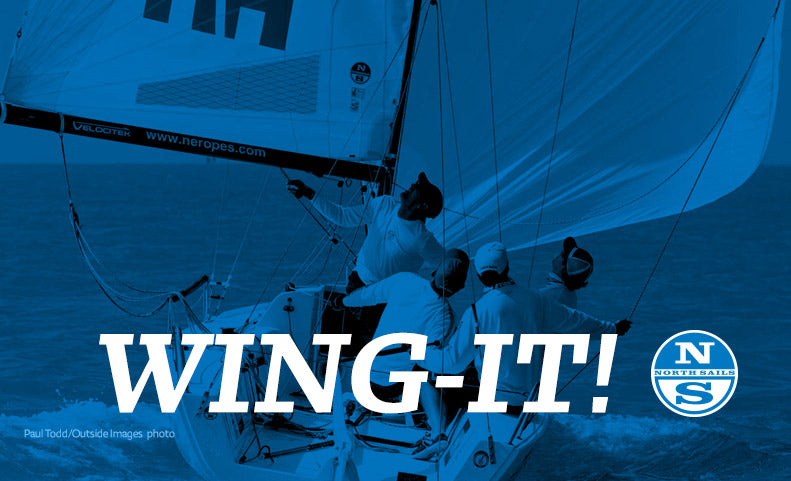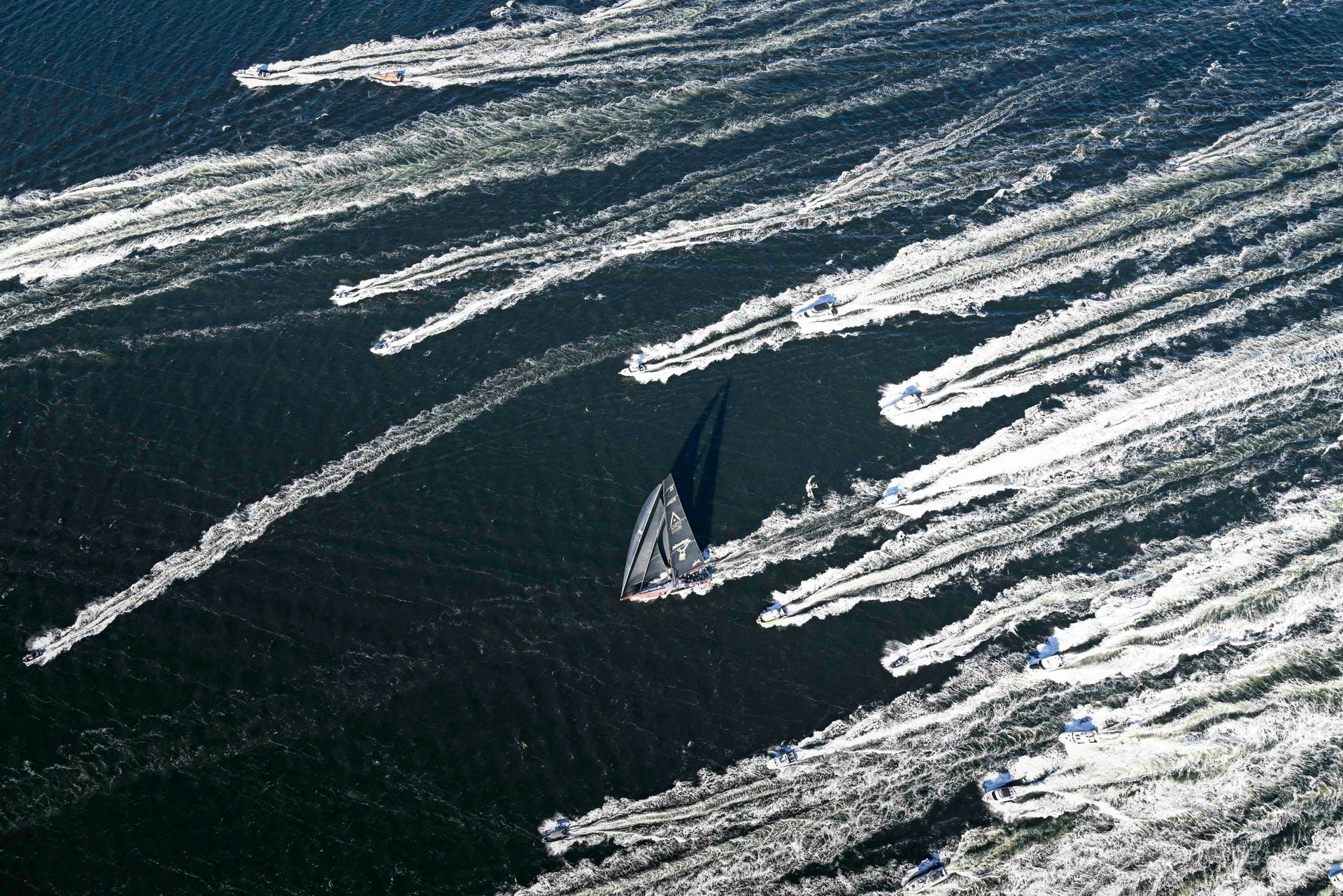VIDEO: WING-ON-WING DOWNWIND TECHNIQUE
WING-ON-WING WITH TIM HEALY
Downwind Technique
The J/70 class at the 2016 edition of Key West Race Week saw more of the same in addition to a new twist. As in previous years the J/70s had the largest fleet (54 boats) and some of the toughest racing against a very talented group of sailors. What was new this year was how many of those sailors were sailing their boats on the downwind legs.
Sport boats like the J/70, with asymmetrical spinnakers, sail faster at higher angles, but the trend in Key West this year was to sail the boats Wing-on-Wing downwind. At first, the sight of these sport boats attempting to sail straight downwind seems counter-intuitive, but many seemed to be making it work to their advantage. Not really a big surprise that there is something to gain from sailing the straightest course to the mark while other boats in the fleet sail traditionally higher sailing angles and longer distances.
After talking with some of the J/70 sailors in Key West, this new downwind mode has resulted many teams practicing and perfecting the specifics of the Wing-on-Wing trimming and sail handling. However, even with teams practicing, the big question for the boats attempting this unorthodox downwind mode is: When does it work and when is it better to keep this mode in the bag? Wing-on-wing can provide an advantage in certain conditions and situations. If it is used at the wrong time, distance can easily be lost to other boats in the fleet. Our team, having practiced sailing wing-on-wing in a variety of wind conditions and sea states, has decided that the maneuver is something to be used sparingly.
WHEN IS THE BEST TIME TO SAIL WING-ON-WING?
We have found that there are 3 criteria that need to be met in order for Wing-on-Wing to be an effective option. Those criteria are:
1. Wind Speed
The amount of true wind is important because the asymmetrical spinnaker is unstable and difficult to fly when sailing straight downwind. If the wind is too light, the pressure in the spinnaker will not be enough to help it fly away from the boat while on the wing. 9-13 knots of wind seems to be the sweet spot for the wing mode. Basically, enough wind to fly the sail Wing-on-Wing and not yet, windy enough to plane.
2. Boatspeed
Once sailing Wing-on-Wing, boat speed is the test to see if the downwind mode is working or not. Our criterion for boat speed is after changing our mode from VMG towing-on-wing we ask, how much did our speed drop? For the wing mode to be effective, there has to be little or no speed loss relative to the boats sailing the VMG mode. Since Wing-on-Wing is most effective in the same conditions as the normal VMG mode, the speeds while sailing in pressure should be comparable and the gains made are due to sailing the shorter distance(lower angle) downwind.
3. Sailing Lane
Sailing the traditional VMG mode downwind allows a range of sailing angles, like sailing higher in the lulls and lower in the puffs. When sailing Wing-on-Wing, the mode demands a very specific sailing angle in order to fly the sail and it is important to ensure that your sailing lane is clear because changing course can easily collapse the spinnaker. We always have someone watching behind while on the wing to make sure our land and wind is clear and we are able to sail the proper angle while on the wing.
After deciding to switch from VMG mode to Wing-on-Wing, the technique and boat handling can make or break the success of the maneuver. Here some of the boat handling tricks we use to help get to the wing mode, stay Wing-on-Wing and switch back to VMG mode.
Going from VMG to Wing-on-Wing
Transitioning from the normal VMG mode toWing-on-Wing is best achieved by gybing the mainsail and keeping the spinnaker flying on its current side. When the crew is ready, the boat is turned downwind and the main is pulled across to the other side. As the boom crosses the centerline, the boomvang should be pulled tight to help flip the full battens and avoid catching on the backstay. While the main is gybing, one crew member should stand up and briefly hold out the spinnaker sheet in order to keep the clew of the sail from falling in toward the boat.
Angle of Heel
Once the main has been gybed, the boat should be quickly heeled to windward (boom up) about 10-12 degrees. The skipper or other crew member should continue to hold the spinnaker sheet away from the boat while the trimmer maintains the sheet tension. Maintaining windward heel is critical to keeping the clew of the spinnaker away from the boat, especially in the lulls.
Apparent Wind Angle
Along with the proper heel angle, maintaining the most efficient apparent wind angle is also important sailing Wing-on-Wing. We have found that sailing an apparent wind angle of 5-10 degrees higher than straight downwind is the best to keep the spinnaker flying and will maximize boat speed. Sailing too high could cause the sail to collapse and sailing too low will cause the main to shadow the spinnaker decreasing the pressure in the sail.
Back to VMG mode from the Wing
Switching back to VMG mode from Wing-on-Wing can be done by gybing the main or the spinnaker. Gybing the main is the quickest and easiest. Turn the boat into the gybe and like going to wing mode, as the main is crossing the centerline pull the boomvang tight to help it clear and fill on the new side. Rolling during the gybe will also help the boat turn and allow the crew to flatten the boat after the gybe aiding in acceleration. The other option back to VMG mode is to gybe the spinnaker. Simply, boat is heeled to leeward and turned up as the spinnaker is rotated to the new side. To help the spinnaker switch sides, and prevent it from wrapping, the trimmer should start rotating the sail just before the boat is turned.
After all the practice and racing in Key West, totaling around 50 downwind legs, I would say we used Wing-on-Wing mode on about 10-15 legs during the week. Of the legs where wing mode was used by our team, we averaged about 1-2 minutes per attempt and would switch back quickly to VMG when we were not gaining or after we had already consolidated our position on boats near us. Not every attempt we made at Wing-on-Wing worked in our favor, in fact during the event we were learning which situations were working best for our boat. Anytime we felt a loss in either our relative position, or distance on boats around us, we noted the reasons why the mode was less productive. Normally, our Wing-on-Wing losses were due to one or both of two factors…
1. Not Enough Wind
Because of a drop in pressure or being blanketed by another boat.
2. Bad Lane
Forcing us to change our apparent wind angle outside the optimum for the wing mode.
In the end, our team will be practicing ourWing-on-Wing mode more often to help ourselves and others better understand when to (and not to) use it on our way to the finish line.
North Sails One Design is proud of our continued commitment to developing the fastest sails and providing the best personal service and support for J/70 sailors. The proven performance along with our team of J/70 experts to help you to GO BEYOND is unmatched. Let us know if you need any assistance with sails or getting ready for your next regatta.









